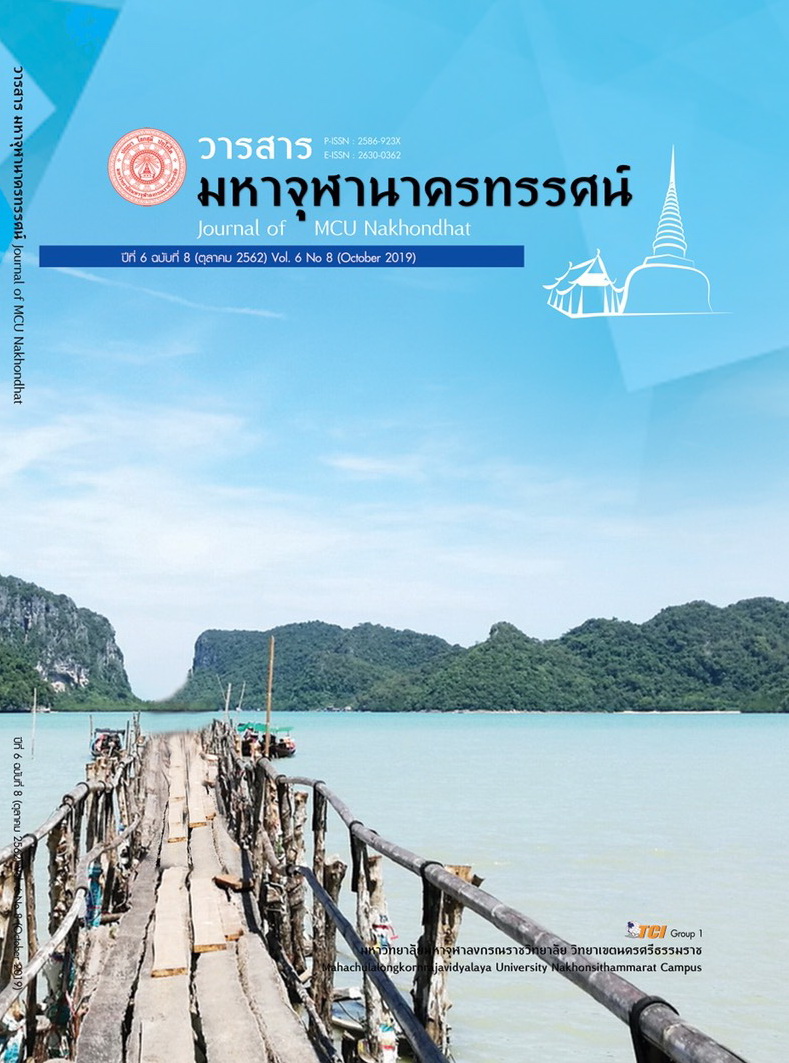THE APPLICATION OF BUDDHIST ETHICS FOR DEVELOPING THE LIFE QUALITY THROUGH THE SHADOW PUPPET PLAYS OF NANG ATTHAGHOSIT (CHIN DHAMMAGHOT)
Main Article Content
Abstract
The objectives of this dissertation are as follows: 1) to study the history and compositions of Nang Atthaghosit (Chin Dhammaghot) Performance, 2) to study Buddhist Ethics for life’s quality development, 3) to apply the Buddhist Ethics for life’s quality development through the shadow play of Nang Atthaghosit (Chin Dhammaghot), 4) to create a new body of knowledge and development model of life’s quality derived from the application Buddhist Ethics through the Shadow Plays. This research was a qualitative research focus on document study. The presentation was the analytical description through the analytic, appreciative and applicative approach so as to lead to the creativity of a new body of knowledge in philosophy.
The results of research were found as follows:
- The history and compositions of Nang Atthaghosit (Chin Dhammaghot) Performance found that Nang Atthaghosit (Chin Dhammaghot) was born on september 27, 1931 at Ban Thammaghot, Moo 3, Sathing Mo Subdistrict, Mueang Songkhla District (now Singha Nakorn District), Songkhla Province. He has performed shadow play since childhood, not less than 6,000 shadow plays both domestically and internationally, died in his hometown on 29 May 2017, a total of 86 years of age. The composition in the shadow play of Nang Atthaghosit (Chin Dhammaghot) consists of Shadow group, theaters and instruments, musical instruments and shadow play (rup nang thalung) with the same acting process as traditional southern shadow.
- The Buddhist ethics for life’s quality development found that Buddhist ethics for life’s quality development is inserted in the shadow play catchphrase of Nang Atthaghosit (Chin Dhammaghot) almost every story. Both basic Buddhist ethics (the five precepts, the five ennobling virtues), intermediate level (wholesome course of action) and advanced level (the noble eightfold path). All principles can be applied to develop the quality of life in 2 levels, namely personal and social level.
- The Application of Buddhist ethics for life’s quality development, looking through Nang Atthaghosit (Chin Dhammaghot) Performance. It was found that Nang Atthaghosit (Chin Dhammaghot) Performance can apply Buddhist ethics for life’s quality development in 2 levels which are 1) the application for life’s quality development at the individual level, 2) the application for life’s quality development at the social level.
- A new body of knowledge and model of life’s quality development from the application of Buddhist Ethics through Nang Atthaghosit (Chin Dhammaghot) Performance found that the new body of knowledge called the Model of Application the Buddhist Ethics for life’s quality development looking through Nang Atthaghosit (Chin Dhammaghot) is the model “S-B-P-L & 3Es” which is a new body of knowledge that the audiences of Nang Atthaghosit (Chin Dhammaghot) Performance can be applied for life’s quality development to achieve a sustainable peace.
Article Details
References
เกษม ขนาบแก้ว และคณะ. (2560). “หนังอรรถโฆษิต” หนังตะลุงนามพระราชทาน ฉิ้น อรมุต หนังฉิ้น ธรรมโฆษณ์ ศิลปินแห่งชาติ ปราชญ์ผู้ขับเงาแห่งลุ่มทะเลสาบสงขลา. กรุงเทพมหานคร: บริษัท สยาม เอ็ม แอนด์ บี พับลิชชิ่ง จำกัด.
ปาจรีย์ ลัภบุญ. (2550). การสื่อสารวัฒนธรรมผ่านสื่อหนังตะลุงคณะฉิ้น ธรรมโฆษณ์. ใน วิทยานิพนธ์นิเทศศาสตรมหาบัณฑิต สาขาวิชานิเทศศาสตร์. มหาวิทยาลัยสุโขทัย ธรรมาธิราช.
พระครูปลัดสุรศักดิ์ วิริยธโร (คงรักษา). (2555). การพัฒนาทรัพยากรมนุษย์ตามหลักเบญจศีลและเบญจธรรม. ใน วิทยานิพนธ์พุทธศาสตรมหาบัณฑิต สาขาวิชาการบริหารจัดการคณะสงฆ์. มหาวิทยาลัยมหาจุฬาลงกรณราชวิทยาลัย.
พระมหาพรสวรรค์ กิตฺติวโร (จันโปรด). (2554). ศึกษาการพัฒนาทรัพยากรมนุษย์ตามหลักกุศลกรรมบถ 10 ประการ. ใน วิทยานิพนธ์พุทธศาสตรมหาบัณฑิต สาขาวิชาพระพุทธศาสนา. มหาวิทยาลัยมหาจุฬาลงกรณราชวิทยาลัย.
พระมหาอนุรักษ์ อภิรกฺโข (เจ้ยทอง). (2550). หนังตะลุงกับการเผยแผ่ธรรมแก่ประชาชน: กรณีหนังตะลุงคณะสุรเชษฏ์ บันเทิงศิลป์ จังหวัดนครศรีธรรมราช. ใน วิทยานิพนธ์พุทธศาสตรมหาบัณฑิต สาขาวิชาธรรมนิเทศ. มหาวิทยาลัยมหาจุฬาลงกรณราชวิทยาลัย.
สมหวัง คงประยูร. (2522). ศิลปะพื้นบ้าน. เชียงใหม่: โรงพิมพ์ส่งเสริมธุรกิจ.
โสภา สมเขาใหญ่. (2538). ชีวิตและผลงานวรรณกรรมหนังตะลุงของฉิ้น ธรรมโฆษณ์. ใน วิทยานิพนธ์ศิลปศาสตรมหาบัณฑิต สาขาไทยคดีศึกษา. มหาวิทยาลัยศรีนครินทรวิโรฒภาคใต้.
อุดม หนูทอง. (2529). หนังตะลุง ในสารานุกรมวัฒนธรรมภาคใต้ เล่ม 10. กรุงเทพมหานคร: โรงพิมพ์อมรินทร์การพิมพ์.


